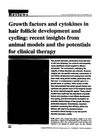TLDR Activating the Sonic hedgehog gene in mice can start the hair growth phase.
In 1999, researchers conducted a study on postnatal mice to investigate the role of the Sonic hedgehog (Shh) gene in hair growth. They found that transient, localized overexpression of Shh initiated the anagen growth phase of hair follicles, leading to hair growth. This was achieved by intradermal administration of an adenovirus gene-transfer vector expressing Shh, which resulted in enhanced expression of Shh, Ptc, Gli1, hair-specific keratin, and tyrosinase at the injection site. The study also observed increased hair follicle size, increased dermal and epidermal depth, increased melanogenesis, and increased hair growth. No abnormalities were observed in the skin 6 months after the injection. The study involved 5 mice for each treatment. These findings suggested that transient expression of Shh could potentially activate the hair growth cycle in disease conditions where these functions have been reduced, offering a potential new approach to hair loss therapy. However, this research is 24 years old and may be outdated.
158 citations
,
November 1998 in “Cell” β-catenin affects hair growth and can lead to tumors, needing more research for better understanding.
 32 citations
,
February 1998 in “The journal of investigative dermatology/Journal of investigative dermatology”
32 citations
,
February 1998 in “The journal of investigative dermatology/Journal of investigative dermatology” Two specific hair keratin genes are active during hair growth and decline as hair transitions to rest.
638 citations
,
October 1997 in “Nature”  100 citations
,
November 1996 in “Molecular Medicine Today”
100 citations
,
November 1996 in “Molecular Medicine Today” Growth factors and cytokines are important for hair growth and could potentially treat hair loss, but more research is needed to overcome challenges before they can be used in treatments.
58 citations
,
April 1993 in “Developmental Biology” bFGF delays hair growth in mice.
745 citations
,
February 1992 in “Trends in genetics” Hair follicles create different cell layers and proteins, controlled by various molecules.
 521 citations
,
January 1954 in “Physiological Reviews”
521 citations
,
January 1954 in “Physiological Reviews” Hair growth is cyclic and influenced mainly by local factors.
 25 citations
,
June 2022 in “Developmental cell”
25 citations
,
June 2022 in “Developmental cell” Overactivating Hedgehog signaling makes hair follicle cells in mice grow hair faster and create more follicles.
190 citations
,
July 2006 in “Experimental Dermatology” The hedgehog signalling pathway is key in skin development and basal cell carcinoma, offering insights for prevention and treatment.
14 citations
,
September 2001 in “Archives of Dermatological Research” Blocking hair follicle development stops key gene signals needed for hair growth in mice.
 231 citations
,
October 1999 in “Journal of Clinical Investigation”
231 citations
,
October 1999 in “Journal of Clinical Investigation” Activating the Sonic hedgehog gene in mice can start the hair growth phase.






